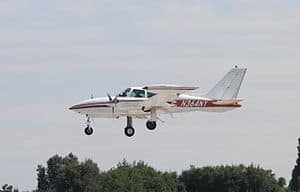
Cessna 310
The Cessna 310 is a four to six seat, low-wing, twin piston engine aircraft with a conventional tail produced by Cessna between 1954 and 1980. Distinguishing features are: retractable landing gear, constant-speed propellers. The 310 seats up to 5 passengers and 1 pilot.
Specifications (1954-57)
Exterior Dimensions
Wing span: 36 ft 11 in
Length: 29 ft 6 in
Height: 9 ft 11 in
Engine
Manufacturer: Continental
Model: O-470-B/M
Horsepower: 240 hp
Overhaul (HT): 1500 TBO or 12 years
Performance
| Horsepower: 240.00 | Gross Weight: 4,600 |
| Top Speed: 191 | Empty Weight: 2,850 |
| Cruise Speed: 178 | Fuel Capacity: 102 |
| Stall Speed (dirty): 71 | Range: 640 |
| Rate of Climb: 1,700 | Rate of Climb (One Engine): 380 |
| Service Ceiling: 19,500 | Ceiling (One Engine): 7,250 |
| Takeoff | Landing |
| Ground Roll: 1,120 | Ground Roll 1,285 |
| Takeoff Roll Over 50 ft: 1,375 | Landing Roll Over 50 ft: 1,710 |
History
The 310 first flew on January 3, 1953, with deliveries starting in late 1954. Competition was Piper's PA-23 Apache, Beech's Twin Bonanza and the Aero Commander 520.
The sleek modern lines of the new twin included tight cowlings and streamlined nose and tip tanks. Innovative features of the day included engine exhaust thrust augmenter tubes and split wing flaps which eliminated the need for external brackets or tracks. Distinguishing features were the multiple aft side windows and storage of all fuel in tip tanks or ‘tuna tanks' named for their odd shape. The tanks hold 50 gallons of fuel each and became the Cessna twin hallmark.
Typical of Cessna model naming conventions, a letter was added after the model number to identify changes to the original design over the years.
Variants
Cessna 310
Initial production variant, powered by two 240 hp Continental O-470-B or O-470-M engines with carburetors, with maximum takeoff weight of 4,600 pounds; in production for 1955-1957 model years, 547 built.
Cessna 310A
Military version of the 310 for the United States Air Force, designated L-27A and later U-3A; with Continental O-470-M engines and maximum takeoff weight of 4,830 pounds; 161 built.
Cessna 310B
Model produced in 1958, with new instrument panel, O-470-M engines, 30 gal auxiliary wing tanks, and maximum takeoff weight of 4,700 pounds; 225 built.
Cessna 310C
Model produced in 1959, with 260 hp Continental IO-470-D fuel-injected engines and maximum takeoff weight increased to 4,830 pounds; and minor changes; 260 built.
Cessna 310D
First model with swept vertical tail, and individual seats; 268 built for 1960 model year.
Cessna 310E
Military version of the 310F, designated the L-27B and later U-3B; with maximum takeoff weight of 4,990 pounds; 36 built.
Cessna 310F
Model produced in 1961, with extra cabin window each side, pointed nose and other interior refinements; maximum takeoff weight of 4,830 pounds; 155 built.
Cessna 310G
In 1962 Cessna introduced the ‘Stabila-Tip' tanks, said to be more aerodynamically efficient than the old ‘tuna' tanks. The old design noncanted and bladder-equipped tip tanks also had a fuel pickup problem, therefore, requiring an AD mandating a large increase in useable fuel. With the bladderless, all-metal canted tanks, swept fin, short nose, and gross weight increased to 4,990 pounds, it was one of the most attractive light twins built. 156 built in 1962.
Cessna 310H
By 1963 Cessna increased cabin size along with gross weight. The Model 310H became a six-seater with an optional six seat, and maximum takeoff weight increased to 5,100 pounds.
Cessna 310I
First model with wing lockers (baggage compartments in rear of engine nacelles) and optional auxiliary tanks. One significant difference was the switch from corrosion prone, overwing exhaust design to an improved underwing exhaust and an engine change to the Continental IO-470-U 260 hp engine with 1500 TBO. 200 built in 1964.
Cessna 310J
Model produced in 1965 with optional auxiliary tanks, and maximum takeoff weight of 5,100 pounds.
Cessna 310K
First model with optional three-blade propellers and long ‘vista view' side windows; also increased maximum takeoff weight of 5,200 pounds with IO-470-V engine; 245 built in 1966.
Cessna 310L
First model with increased fuel capacity via fuel tanks inside wings, single-piece windshield, redesigned landing gear, and minor changes; 207 built in 1967.
Cessna 310N
Model produced in 1968, with revised instrument panel and provision for optional cargo door and optional fuel tanks in engine nacelles;198 built.
Cessna 310P
Model produced in 1969, with Continental IO-470-VO engines, ventral fin and a shorter nose gear leg.
Cessna T310P
In 1969, Cessna consolidated the line by offering a turbocharged variant of the 310P in place of the Cessna 320 Skynight. It came equipped with the Continental TSIO-520-B or TSIO-520-BB engines producing 285 hp, 3-blade props, and maximum takeoff weight of 5,400 pounds; combined total of 240 310P and T310P built.
Cessna 310Q
Last short-nose model, introduced in 1970, with maximum takeoff weight increased to 5,300 lb and detailed changes, from the 401st aircraft fitted with a bulged rear cabin roof with rear view window.
Cessna T310Q
Version of 310Q with turbocharged Continental TSIO-520-B or TSIO-520-BB engines and maximum takeoff weight increased to 5,500 lb; combined total of 871 310Q and T310Q built.
Cessna 310R
Last production model, introduced in the 1975 model year, with 285 hp Continental IO-520-M or IO-520-MB engines; three-blade propellers as standard; a 32 in lengthened nose containing a baggage compartment; improved landing gear; and 5,500 lb maximum takeoff weight.
Cessna T310R
Version of 310R with turbocharged Continental TSIO-520-B or TSIO-520-BB engines; combined total of 1,332 310R and T310R built.

